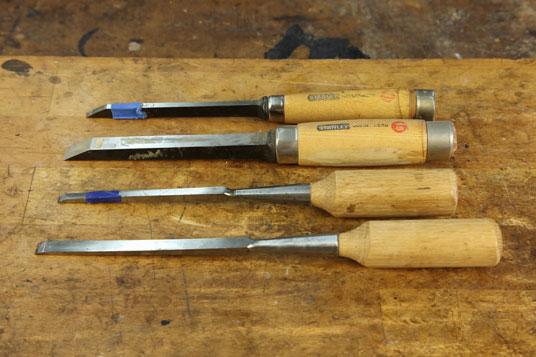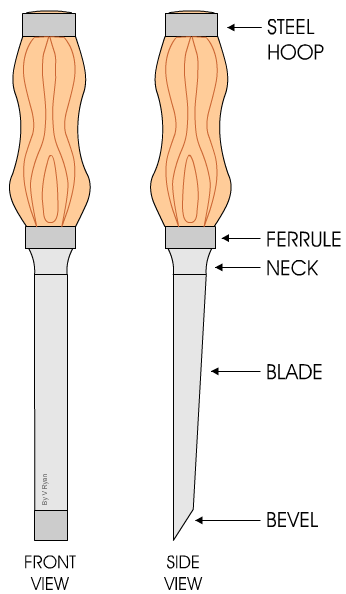Have you ever wondered why mortise chisels are used in woodworking projects? Well, you’re in the right place to find out! In this article, we’ll explore the purpose and benefits of using a mortise chisel. So, let’s dive in and discover why this tool is essential for any woodworking enthusiast.
A mortise chisel is a specialized tool designed to create square or rectangular holes known as mortises. These holes are crucial for joinery techniques like mortise and tenon joints, which provide strong and durable connections in woodworking. So why choose a mortise chisel over other tools? The answer lies in its unique characteristics and functionality.
Unlike regular chisels, mortise chisels have a thicker and stronger blade, specifically designed to withstand the force required to cut through tough hardwoods. This robust construction ensures precise and clean cuts, making it easier to create accurate mortises. Additionally, mortise chisels feature a longer handle, providing better leverage and control during the cutting process.
So, whether you’re a professional woodworker or just starting out, a mortise chisel is an indispensable tool for achieving precise and durable joinery. Get ready to take your woodworking skills to the next level with the help of this essential tool!

Why Mortise Chisel is Used?
Introduction: Mortise chisels are a crucial tool in woodworking, specifically when it comes to creating precise and clean joints. This article will explore the various reasons why mortise chisels are used in woodworking projects.
The Importance of Mortise Chisels in Woodworking
Mortise chisels play a vital role in woodworking for several reasons. Let’s take a closer look at some of the key reasons why woodworkers rely on these tools:
Precision and Accuracy
Mortise chisels are designed to create accurate and precise mortises, which are the slots or pockets that accommodate tenons in joinery. These chisels have a sturdy and sharp blade that allows woodworkers to carve out the necessary depth and width required for the joint. With their flat sides and straight edges, mortise chisels ensure that the mortise is perfectly sized and clean, resulting in a tight and secure joint.
Additionally, mortise chisels often feature a square or beveled edge, allowing woodworkers to create perfectly square mortises, ensuring the joints fit snugly together. The precision offered by mortise chisels is unmatched, making them indispensable in woodworking projects that require strong and durable joinery.
Mortise chisels are also versatile and can be used for various other woodworking tasks, such as cutting straight-sided holes, shaping, and paring.
Efficiency and Time-Saving
One of the primary reasons why mortise chisels are favored by woodworkers is their efficiency and time-saving capabilities. These chisels are specifically designed to remove waste material quickly and accurately, allowing woodworkers to create mortises with ease. The sharpness and the shape of the chisel’s blade, along with proper technique, enable woodworkers to work efficiently and complete projects in a timely manner.
Mortise chisels also offer better control and stability compared to other tools when creating mortises. This advantage translates into a higher level of efficiency as woodworkers can work faster without compromising on accuracy.
The efficiency of mortise chisels is particularly crucial when working on larger projects or when creating multiple joints that require precision and consistency. Investing in a high-quality mortise chisel can save significant time and effort throughout a woodworking project.
Strength and Durability of Joints
Woodworking joints created using mortise chisels are renowned for their strength and durability. The tight fit achieved by accurately sizing the mortise with a mortise chisel ensures a robust joint that can withstand the test of time. This makes mortise chisels an essential tool for constructing furniture, doors, windows, and other wooden structures that require secure and long-lasting joints.
Whether it’s a traditional mortise and tenon joint or a more complex variation, such as a wedged through tenon or a double mortise and tenon joint, the precise cutting ability of mortise chisels ensures that the joint is structurally sound and capable of bearing significant weight and stress.
Moreover, the neat and clean cuts made by mortise chisels reduce the risk of any gaps or unevenness in the joint, further enhancing its strength and durability. This aspect is especially critical in load-bearing joints that must withstand constant use and pressure.
Key Factors to Consider when Using Mortise Chisels
Woodworkers should keep in mind several factors when using mortise chisels to ensure optimal results:
Sharpness and Maintenance
It is essential to keep mortise chisels sharp and well-maintained to achieve clean and precise cuts. Dull or poorly maintained chisels can lead to rough and inaccurate mortises. Regular sharpening, honing, and cleaning of the chisel’s blade are crucial for achieving the best outcomes.
Additionally, using a mallet appropriate for the chisel and striking the tool accurately can help prevent damage or dulling of the blade. Proper technique and maintenance will ensure that the mortise chisel consistently delivers high-quality results.
Safety Precautions
As with any woodworking tool, safety precautions must be followed when using a mortise chisel. Eye protection, such as safety goggles, is crucial to prevent potential injuries from wood chips or flying debris. It is also recommended to use a vise or clamp to secure the workpiece, minimizing any movement that could result in accidents.
Woodworking gloves can provide added protection and improve grip when handling the chisel. Additionally, woodworkers should always pay attention to their body positioning and hand placement to avoid accidental cuts or injuries.
Choosing the Right Chisel
When selecting a mortise chisel, factors such as blade width, length, and handle design should be considered. The appropriate size of the chisel depends on the desired joint size and the type of wood being used. It is essential to choose a chisel that comfortably fits your hand to ensure maximum control during use.
Investing in a high-quality chisel made from durable materials will also contribute to its longevity and overall performance.
Conclusion:
To summarize, mortise chisels are essential tools in woodworking, offering precision, efficiency, and durability when creating joints. Their ability to provide accurate cuts, remove waste material efficiently, and create secure joints makes them indispensable for woodworkers. By considering factors like sharpness, safety, and choosing the right chisel, woodworkers can harness the full potential of mortise chisels and achieve high-quality results in their woodworking projects.
Key Takeaways: Why Mortise Chisel Is Used?
- A mortise chisel is a specialized tool used in woodworking to create rectangular holes called mortises.
- Mortise chisels have a long, sturdy blade that can withstand the force needed to remove material from the wood.
- They are used to create mortises for joinery, such as creating tenons for strong and precise wood joints.
- Mortise chisels are commonly used in furniture making and carpentry projects.
- Using a mortise chisel requires proper technique and safety precautions to ensure accurate and safe results.
Frequently Asked Questions
Welcome to our FAQ section where we answer your burning questions about mortise chisels and their uses. Whether you’re a woodworking enthusiast or just curious about this tool, we’ve got you covered!
Q: How is a mortise chisel different from a regular chisel?
A: While both chisels have a similar basic design, mortise chisels are specifically designed for creating square or rectangular holes, known as mortises. They have a thicker and stronger blade compared to regular chisels, allowing them to withstand the force required to remove wood from the mortise.
Their sturdy construction and beveled edges make them ideal for the task, ensuring clean and precise cuts that fit perfectly with the corresponding tenon.
Q: What are the common uses of a mortise chisel?
A: Mortise chisels are primarily used in woodworking to create mortise and tenon joints, one of the oldest and strongest ways to join pieces of wood together. These joints are commonly found in furniture, doors, window frames, and other wooden structures.
By using a mortise chisel, woodworkers can accurately carve out the mortise, which is the recessed hole, and then shape the tenon, the corresponding projecting part of the wood. This allows for a tight fit, providing stability and strength to the overall structure. Mortise chisels are also handy for repairing or modifying existing mortise and tenon joints.
Q: Can a mortise chisel be used on other materials besides wood?
A: Mortise chisels are specifically designed and constructed for use on wood. Their sturdy blades and sharp edges are optimized for cutting through this material. While it may be tempting to use a mortise chisel on other materials such as plastic or soft metals, doing so can damage the tool and compromise its effectiveness.
If you require similar precision in working with other materials, it’s best to invest in chisels specifically designed for those substances. This will ensure the longevity of your mortise chisel and lead to optimal results in your woodworking projects.
Q: How do I maintain and sharpen my mortise chisel?
A: Regular maintenance and sharpening are crucial for keeping your mortise chisel in top condition. To prevent rust and maintain the blade’s integrity, wipe the chisel clean after each use and apply a light coat of oil. Store it in a dry place away from moisture.
When it comes to sharpening, you can use a sharpening stone or honing guide to restore the chisel’s cutting edge. Follow the angle of the existing bevel and make sure to sharpen both sides evenly. Regularly inspect the chisel for any nicks or dullness, as these can affect its performance and require additional attention.
Q: Are there different sizes of mortise chisels available?
A: Yes, mortise chisels come in various sizes to accommodate different project requirements. The size of the chisel refers to the width of the blade at the cutting edge. Common sizes range from 1/4 inch to 3/4 inch, but larger chisels can also be found.
Choosing the right size depends on the specific mortise dimensions you need to create. Consider the thickness of the tenon and the overall scale of your project. Having a few different sizes on hand allows for more flexibility in creating mortise and tenon joints of varying sizes.

Summary
A mortise chisel is used for cutting square or rectangular holes in wood. This tool helps create strong and secure joints in woodworking projects.
Mortise chisels have a square-shaped blade and a sturdy handle. They are designed to remove a specific amount of wood to form a precise and clean hole.
Using a mortise chisel requires patience and accuracy, as it takes time to carve out the hole evenly. However, the end result is a joint that is not only aesthetically pleasing but also durable and able to withstand heavy loads.
So, if you ever find yourself wanting to create strong and long-lasting joints in your woodworking projects, consider using a mortise chisel. It’s a handy tool that can help you achieve precise and secure connections between two pieces of wood.
